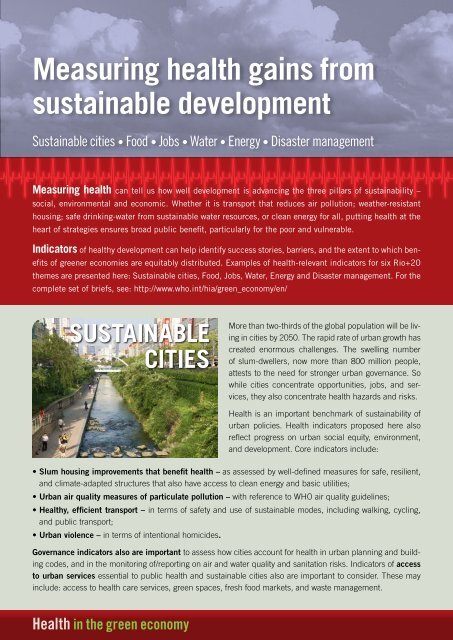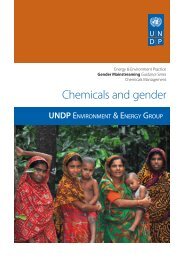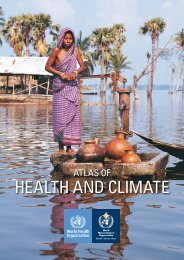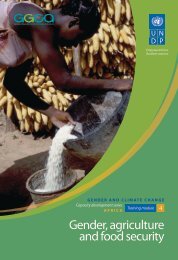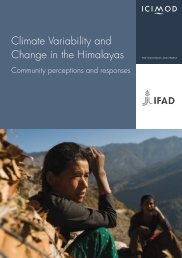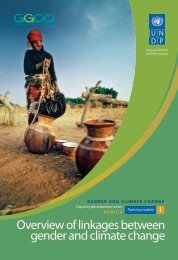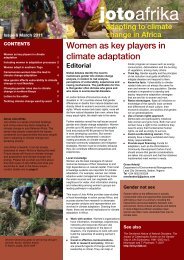Measuring health gains from sustainable development
Measuring health gains from sustainable development
Measuring health gains from sustainable development
- No tags were found...
Create successful ePaper yourself
Turn your PDF publications into a flip-book with our unique Google optimized e-Paper software.
<strong>Measuring</strong> <strong>health</strong> <strong>gains</strong> <strong>from</strong><strong>sustainable</strong> <strong>development</strong>Sustainable cities • Food • Jobs • Water • Energy • Disaster management<strong>Measuring</strong> <strong>health</strong> can tell us how well <strong>development</strong> is advancing the three pillars of sustainability –social, environmental and economic. Whether it is transport that reduces air pollution; weather-resistanthousing; safe drinking-water <strong>from</strong> <strong>sustainable</strong> water resources, or clean energy for all, putting <strong>health</strong> at theheart of strategies ensures broad public benefit, particularly for the poor and vulnerable.Indicators of <strong>health</strong>y <strong>development</strong> can help identify success stories, barriers, and the extent to which benefitsof greener economies are equitably distributed. Examples of <strong>health</strong>-relevant indicators for six Rio+20themes are presented here: Sustainable cities, Food, Jobs, Water, Energy and Disaster management. For thecomplete set of briefs, see: http://www.who.int/hia/green_economy/en/SustainableCitiesMore than two-thirds of the global population will be livingin cities by 2050. The rapid rate of urban growth hascreated enormous challenges. The swelling numberof slum-dwellers, now more than 800 million people,attests to the need for stronger urban governance. Sowhile cities concentrate opportunities, jobs, and services,they also concentrate <strong>health</strong> hazards and risks.Health is an important benchmark of sustainability ofurban policies. Health indicators proposed here alsoreflect progress on urban social equity, environment,and <strong>development</strong>. Core indicators include:• Slum housing improvements that benefit <strong>health</strong> – as assessed by well-defined measures for safe, resilient,and climate-adapted structures that also have access to clean energy and basic utilities;• Urban air quality measures of particulate pollution – with reference to WHO air quality guidelines;• Healthy, efficient transport – in terms of safety and use of <strong>sustainable</strong> modes, including walking, cycling,and public transport;• Urban violence – in terms of intentional homicides.Governance indicators also are important to assess how cities account for <strong>health</strong> in urban planning and buildingcodes, and in the monitoring of/reporting on air and water quality and sanitation risks. Indicators of accessto urban services essential to public <strong>health</strong> and <strong>sustainable</strong> cities also are important to consider. These mayinclude: access to <strong>health</strong> care services, green spaces, fresh food markets, and waste management.Health in the green economy
FoodMany food-related diseases and conditions – includingundernutrition, micronutrient deficiency, andobesity as well as food safety risks and farmworker<strong>health</strong> – are interlinked. Sustainable food policies thatplace the promotion and protection of <strong>health</strong> at thecore of strategies <strong>from</strong> the farm field to the dinnerplate can help advance the provision of <strong>sustainable</strong>,quality foods for all, across the supply chain and thehuman life-cycle. 1 Health indicators that can be usedto monitor progress include:• Health outcomes: prevalence of anaemia inwomen, particularly of reproductive age; prevalenceof stunting in children under 5 years; and prevalenceof obesity in children under 5 and in adults.• Food access and dietary quality in association with<strong>sustainable</strong> foods production: adequate accessto protein supply; excessive adult saturated fatconsumption; household dietary diversity; and prevalence/incidenceof foodborne disease outbreaks.• Food market/trade policies supporting <strong>health</strong> andsustainability: foods that comply with internationalfood safety standards including hormone, pesticides,and antibiotic residues; number of countriesthat have phased out use of antibiotics as growthpromoters; and assessment of <strong>health</strong> and sustainabilityimpacts in agricultural trade negotiations,policies, and plans.JobsA <strong>health</strong>y workforce is a prerequisite for social andeconomic <strong>development</strong>; fair terms of employmentand decent working conditions are critical to the<strong>health</strong> of the working-age population.• More systematic measurement and reporting ofworkers’ <strong>health</strong> can help reduce work-related injuries,illnesses, and deaths. In 2011, an estimated2.3 million people died <strong>from</strong> work related injuries,illnesses, and accidents.• Compliance with basic national occupational safetyand <strong>health</strong> standards, at country level and by sector,can support improved workers’ <strong>health</strong>, including inthe transition to a green economy.• Monitoring progress on the ratification and implementationof core international labour conventionscovering occupational safety and <strong>health</strong> policiesand occupational <strong>health</strong> services is a third measuresupporting improved workers’ <strong>health</strong> and safety.Health in the green economy
WaterMeasurement of access to safe and climate resilientdrinking-water resources, as well as sanitation,is increasingly critical in an era of continued populationgrowth and climate change. Ensuring access tosafe, resilient and <strong>sustainable</strong> water and sanitationwill accelerate attainment of multiple environmentand <strong>health</strong>-related goals for <strong>sustainable</strong> <strong>development</strong>.• Indicators of access to safe drinking-water requiregreater refinement to reflect the large, continuinggaps in access to safe drinking water among theworld’s poorest populations, and measure progresstowards attainment of the universal right to water.• Monitoring access to adequate climate-resilientwater and sanitation systems is particularly criticalin light of the increasing impacts of temperaturechange and extreme weather on water sources,sanitation systems and human <strong>health</strong>.• Greater inclusion of public <strong>health</strong> agencies inIntegrated Water Resource Management (IWRM)will accelerate the broader application of IWRM,which provides a comprehensive and multisectoralapproach for the identification and management ofwater-related <strong>health</strong> risks.ENERGYHealth offers a universal indicator of progress in attainingthe UN Secretary General’s goals for Sustain ableEnergy for All. 2Close to 1.3 million deaths annually are due to urbanair pollution. Some 2 million people die <strong>from</strong> householdair pollution every year. Improving household access tomodern energy sources, while shifting to cleaner andmore efficient modes of community energy generationand distribution, can reduce <strong>health</strong> impacts <strong>from</strong> bothindoor and outdoor pollution. This will benefit millionsof people today and contribute to long-term <strong>health</strong> byreducing the escalating impacts of climate change.• Monitoring reductions in air pollution-related diseasesprovides an important measure of the social<strong>gains</strong> <strong>from</strong> a shift to more <strong>sustainable</strong> energy.• Progress in transition to more efficient energygeneration and distribution, including greater useof renewables, is also important to <strong>health</strong>.Some key <strong>health</strong>-relevant indicators of progress on<strong>sustainable</strong> energy include measurement of:––Household access to modern, low-emissions heatingand cooking technologies;––Electricity access at home and in <strong>health</strong> facilities;––Burden of air pollution-related diseases and injuries;––Health equity impacts of energy policies;––Clean electricity power generation across the energysupply chain – in terms of pollution and greenhousegas emissions and a shift to renewable energy.Health in the green economy
DisastermanagementHealth system resilience and capacity for emergencyrisk management are critical to effective disaster managementthat supports long-term goals of <strong>sustainable</strong><strong>development</strong>.• Monitoring and reporting on the human <strong>health</strong>aspects of disasters – as part of measures to improverisk assessment, prevention, preparedness, response,and recovery – is important for strengthening disasterrisk management. This will help reduce <strong>health</strong> impacts,particularly the loss of human lives.• Building <strong>health</strong> system resilience and capacity foremergency risk management, particularly at a community level, is critical to effective disaster management.• Indicators of <strong>health</strong> system resilience to natural disasters include the proportion of <strong>health</strong> facilities, newand improved, to withstand hazards, and with access to reliable clean energy and water supplies, routinelyand in emergencies.References1. Schutter OD. Report submitted by the Special Rapporteur on the right tofood, Olivier De Schutter. New York City, United Nations Human Rights Council,2011 (http://www.unscn.org/en/announcements/conferences/?id=650).2. Energy for a <strong>sustainable</strong> future: summary report and recommendations.New York, United Nations Secretary General’s Advisory Committee Groupon Energy and Climate Change, 2010.© World Health Organization 2012All rights reserved. Publications of the World Health Organization are availableon the WHO web site (www.who.int). The designations employed and thepresentation of the material in this publication do not imply the expression ofany opinion whatsoever on the part of the World Health Organization concerningthe legal status of any country, territory, city or area or of its authorities, orconcerning the delimitation of its frontiers or boundaries.The statements, opinions or conclusions contained herein, reflect the discussionsof an expert consultation and available evidence. All reasonableprecautions have been taken by the World Health Organization to verify theinformation contained in this publication. However, the published material isbeing distributed without warranty of any kind, either expressed or implied.The responsibility for the interpretation and use of the material lies with thereader. In no event shall the World Health Organization be liable for damagesarising <strong>from</strong> use.The statements, opinions and conclusions contained herein do not necessarilyrepresent the statements, opinions or conclusions of the NIEHS, NIH or theUnited States government.Cover photo: Seoul, South Korea – urban highway transformed to park andwaterway. Zack Lee, via Flickr.com (riacale)Inside and back cover photos, left to right: ©FAO/Giuseppe Bizzarri;Nic Bothma/Kuyasa CDM; stock photo; stock photo; WHO/Armando WaakDesign by Inís Communication – www.iniscommunication.comWHO/HSE/PHE/7.6.2012These briefings present initial findings <strong>from</strong> a WHOExpert Consultation, 17–18 May 2012 in Geneva. Theconsultation included over 40 participants with expertisein <strong>health</strong>, equity, <strong>development</strong> and environment<strong>from</strong> research institutions, government, and multi- lateral/bilateral <strong>development</strong> agencies.The briefings also draw upon previous work by WHOand WHO regional offices on <strong>health</strong> in the green economy;urban transport and housing; <strong>health</strong>y cities; socialdeterminants of <strong>health</strong>; gender; traffic injury; dietand physical activity; disaster management; as well asframeworks for indicators and assessment of <strong>health</strong> equity;<strong>health</strong> risks and environmental burden of disease.The expert consultation was co-sponsored and supportedby the National Institute of Environmental HealthSciences, USA.Public Health & Environment Department (PHE)Health Security & Environment Cluster (HSE)World Health Organization (WHO)Avenue Appia 20, CH-1211 Geneva 27, Switzerlandwww.who.int/phe/en/http://www.who.int/hia/green_economy/en/index.htmlHealth in the green economy


